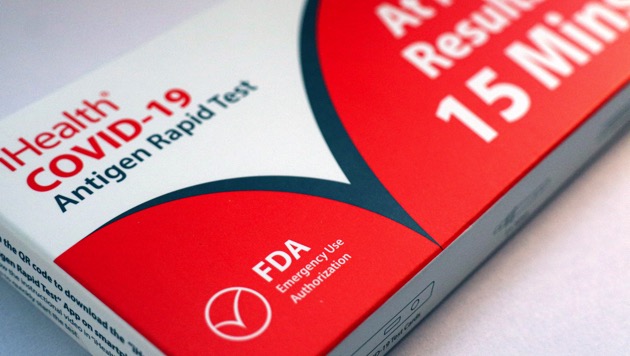When you should be using your at-home COVID tests

(NEW YORK) — Millions of Americans have purchased rapid COVID-19 tests online or at local stores and signed up to receive test kits through a free government program.
Unlike conventional, lab-processed PCR tests, which may detect infection earlier in the course of illness but can take days to get a result, at-home rapid tests can let you know if you are likely contagious in less than 15 minutes. Many specialists see them as a crucial tool in the off-ramp to the pandemic — assuming Americans know how and when to use them.
Public health specialists say rapid tests are good for a range of scenarios, including testing after symptoms and to lower the risk of passing the virus to others, including children not yet eligible for vaccination or those at higher risk for severe illness.
“In the last two months alone, I’ve used home testing for all three of the major indications: experiencing COVID symptoms, after a known COVID exposure and prior to a gathering indoors with higher-risk individuals,” said Dr. Alok Patel, clinical assistant professor of pediatrics at Stanford University.
Test if you have symptoms
“Ultimately, if you’re noticing something has changed and are experiencing unusual symptoms, that’s a good reason to test yourself,” said Dr. Todd Ellerin, director of infectious diseases at South Shore Health in Weymouth, Massachusetts.
Symptoms of COVID-19 include fever, cough, congestion, sore throat, muscle aches, fatigue, headaches, vomiting and diarrhea. Several COVID-19 symptoms overlap with the common cold or the flu and the only way to really know the difference is through testing. So if you have symptoms, stay home and be sure to test.
Test to protect others
Even if you do not have symptoms, testing is helpful after possible or known exposures, before indoor or large gatherings, prior to travel or when seeing high-risk or immunocompromised individuals.
“I use tests before I gather unmasked with friends and family who are at high risk of hospitalization if they develop COVID-19. I am particularly cautious around people receiving cancer treatment and relatives living in assisted-living facilities,” said Dr. Alyssa Bilinski, assistant professor of health policy at Brown School of Public Health.
Some schools with children too young to be eligible for vaccinations require weekly rapid tests Monday mornings before starting the week. Other schools allow vaccinated students to return after a known exposure using rapid tests to make sure they remain negative in a program called “test to stay.”
Test if you’ve been exposed
“If you are asymptomatic but have been within 6 feet of an individual with COVID-like symptoms or a positive test for a combined total of 15 minutes or more during a 24-hour period, you should get tested,” said Dr. Jay Bhatt of Family Christian Health Center near Chicago.
The Centers for Disease Control and Prevention have an online Coronavirus Self-Checker that can help you decide when to test.
Vaccination status should not affect testing decisions or interpretation of results. “With omicron’s higher rates of breakthrough, testing broadly applies to everyone regardless of vaccination status,” said Dr. John Brownstein, epidemiologist at Harvard University.
Taking a test and interpreting results
Make sure your at-home test is authorized by the Food and Drug Administration and follow the manufacturers’ instructions exactly, from storage to sample collection to expiration. So far, FDA-authorized over-the-counter rapid tests use nasal swabs, but do not require you to go very deep into the nose. Some require mixing solution and/or dropping three, four or six drops on a card, but they are all designed for adults who are not health care workers.
Rapid tests are very reliable if they come back positive, but if they record a negative, a confirmation PCR test may be necessary at least 24 hours later. So if you test positive, especially if symptomatic, it is safe to assume you have COVID-19 and should quarantine according to CDC guidelines.
In contrast, negative results can be less accurate and should be interpreted with a tiered approach.
If you are symptomatic but test negative, a false negative is possible. Negative tests should also be interpreted with caution if you’ve had a known COVID contact or possible exposure, like travel.
In this scenario, it is critical to do serial tests at least 24 hours apart. Follow your test’s specific instructions. Rapid test results can change quickly, so a negative test is only trustworthy for eight to 12 hours. If quarantining is not feasible while you serially test, mask and distance as best as possible.
You can consider PCR testing if you need more definitive results, although if you’ve previously had COVID-19, a PCR test can be positive for up to three months afterward.
“If I have symptoms and my rapid test is negative, I will do a PCR. If I am asymptomatic and an initial rapid is negative, I will test for two more days in 24-hour intervals and continue masking and distancing as best as possible. If I have to be with someone who is high-risk or immunocompromised, I would get a PCR test before being around that individual,” said Bhatt.
The Biden administration has purchased 1 billion rapid tests and any household in America can order a set of four tests at no cost through covidtests.gov. Tests are also available at many pharmacies and online stores. Insurance companies are required to reimburse each family member for up to eight OTC rapid tests per month, but consumers must initially lay out $10 to over $30 per test.
“If we’re hoping to test as many people as possible, home testing cannot be cost-prohibitive,” said Dr. Simone Wildes, an infectious diseases specialist at South Shore Health.
While using at-home tests is a new skill we are all learning, the key is to take a thoughtful, stepwise approach based on your risk factors, exposures, symptoms and possibility of transmission.
“Do your due diligence just like you check the weather. Before we go outside, we check to see if we need a raincoat or an umbrella and grab equipment to protect ourselves from exposure,” said Dr. Darien Sutton, an emergency medicine physician and ABC News contributor.
“We should think of this virus in the same way,” he added.
Nitya Rajeshuni, M.D., M.S., a pediatrics resident at the Children’s Hospital of Philadelphia, University of Pennsylvania, is a contributor to the ABC News Medical Unit.
Copyright © 2022, ABC Audio. All rights reserved.
You Might Also Like



